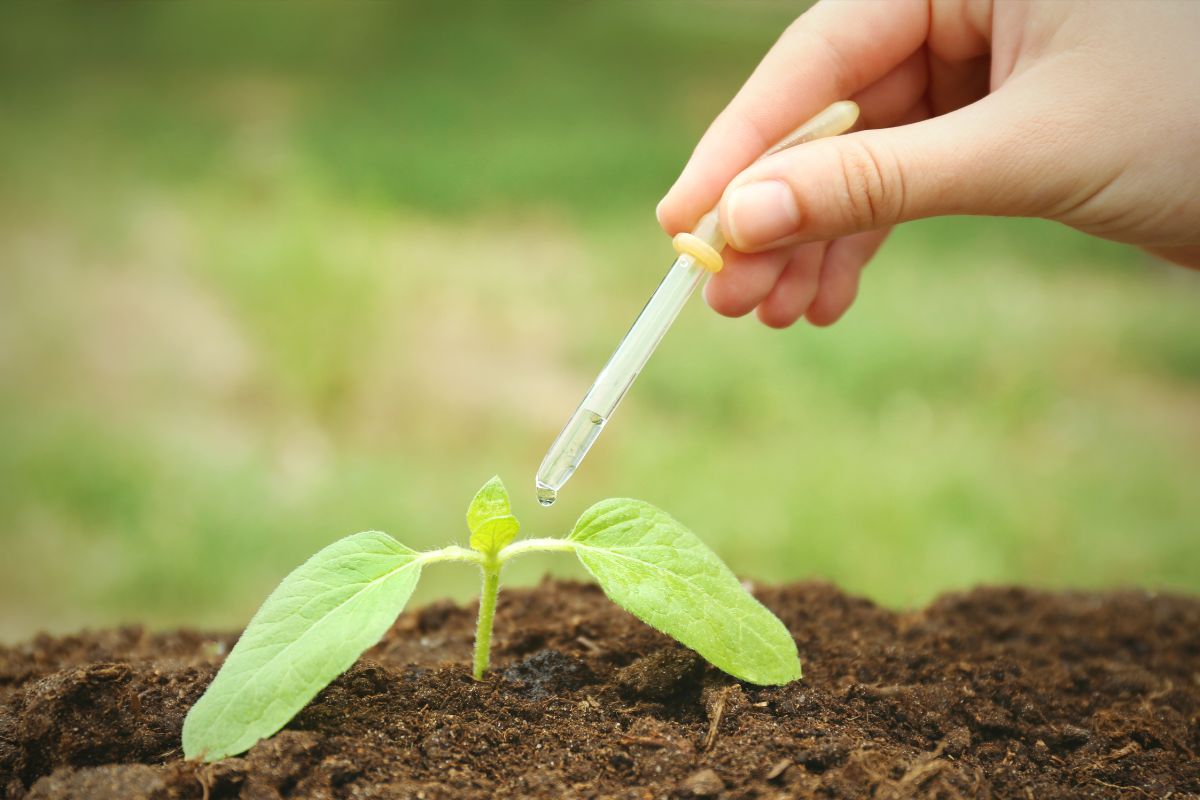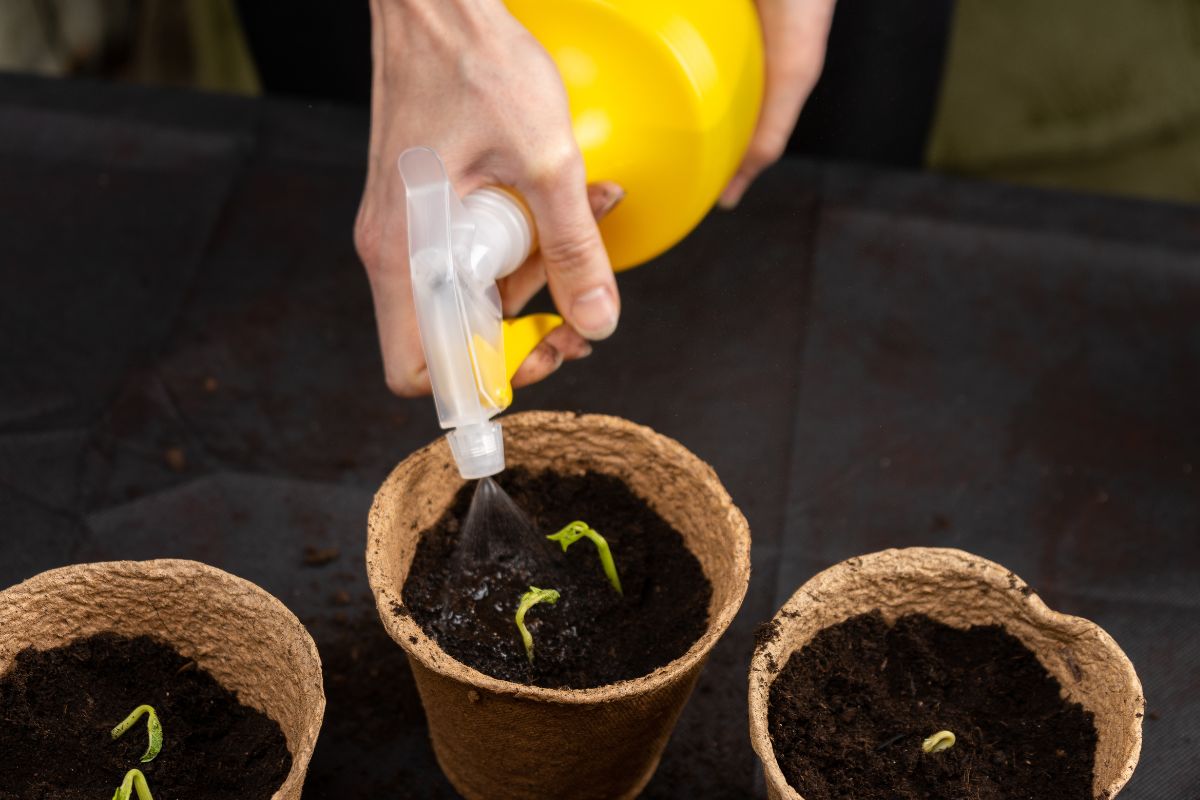Watering seeds and seedlings is a balance between giving too much water and keeping them from drying out. It’s hard enough caring for our plants at these delicate stages without worrying about splashing around the delicate seeds or washing them away completely.
The first step to successfully watering seeds and young plants is to make sure the soil is moist before you plant. As your seeds germinate and grow, there are some excellent ways to keep your soil moist including bottom watering, misting, and using a waterer with a fine nozzle. Or you can use a modified soft drink bottle, eye dropper, or what about a DIY water-wicking system.
Plus, there are many tricks to keep the soil moist, so you will rarely even have to water!
Let’s look at each of these methods in detail so you can find the way that works best for your garden.
Best Methods to Successfully Water Seeds and Seedlings
Not only is it important to give your seeds the right amount of water, but it is also important how you water them. If seeds are sown deep (like nasturtium or beans), you need to make sure the water gets down deep enough to reach the seeds. In shallow plantings (like lettuce) a heavy watering can wash the seeds right out of the row or container.
While you want to give your seeds plenty of moisture, dumping on too much water or other improper watering methods can:
- Wash seeds away.
- Cause seeds to float to the surface.
- Push seeds too deep into the soil.
- Displace or move seeds.
- Disturb seedling roots.
- Result in poor moisture distribution (leading to either overwatering or underwatering).
These problems are common in loose potting soil but can also occur in the garden. So, no matter where you are gardening, here are the most successful methods to water seeds and seedlings:
Water Soil Before Planting
Moistening your growing medium before planting has several advantages. First, it means your soil won’t need as much water at the beginning, reducing the chance of displacing or washing away the seeds. Second, it binds the soil together so there is less chance of seed displacement. Third, it helps keep the soil from drying out since many growing mediums are difficult to rehydrate once dry.
Pre-moisten your growing medium with these simple steps:
- Fill a large container with your potting soil.
- Add water and mix until the soil just starts to hold its shape when squeezed in your hand.
- It is TOO WET if you can squeeze water out. It is TOO DRY if the soil still crumbles between your fingers.
- Fill your pots or trays and start planting.
TIP: When growing seeds consistent light watering is usually more effective than an occasional deluge, so check your soil regularly and water as needed. How often you will need to water depends on temperature, growing medium, and container size.
Bottom Watering
Bottom watering is probably the most effective way to keep your soil moist. It relies on capillary action to absorb water through holes in the bottom of the containers until the soil is even moist.
Make sure your pots or trays have holes in the bottom and set them inside a solid container. Fill the bottom container with water until about ¼ of the pots are submerged. Let the pots sit for 15 minutes to 1 hour depending on how dry your soil is, or until the top of the soil is moist.
It is very important to dump out any excess water since you don’t want your plants to stand in water or they will become waterlogged and rot.
Bottom watering keeps the entire growing medium sufficiently moist, and it is great for rehydrating your soil if it completely dries.
Misting
Watering seeds and seedlings with a mister is a very common practice. The fine mist provides moisture without disturbing seeds or young seedlings and it is especially effective when you pre-moisten your soil.
The downside of misting is that it does not penetrate very deep into the soil. While it maintains an even surface moisture, deep planted seeds can dry out. To combat this, misting is very effective when paired with bottom watering.
Fine Nozzle
Many watering cans now come with a very fine rose (or nozzle). These provide more water than a mister, but they will not displace the seeds as easily as a conventional watering can.
You can also make your own seedling waterer with an empty soft drink bottle. Using a pin or very small nail, make several holes in the lid, fill the bottle with water, and the water will trickle gently onto your plants.
Eye Dropper
For a very accurate waterer, you can use an eye dropper or syringe. While this is unpractical and time consuming if you have lots of seedlings, it will allow you to direct water exactly where you want it, or even put it right under the soil.
For larger containers, you can also use a turkey baster.
Reduce need for watering
The most environmentally friendly way to water your seedlings is to set up a growing environment that reduces the need for watering in the first place.
There are several techniques to help avoid watering and keep your seeds moist, including:
- Use a transparent cover: This can be a cloche, humidity dome, plastic kitchen wrap, or a plastic milk jug with the bottom cut off. Moisture will evaporate from the soil, collect on the cover, and then drip back onto the soil like rain. Make sure to keep the plantings out of direct sunlight to prevent overheating, and make sure the environment under the cover does not get too wet or you will have mould growing.
- Choose a good growing medium: Most seed starting mixes are ideal for sowing seeds and usually contain coir or peat moss. However, both of these materials are hydrophobic which means they are very difficult to rehydrate once they dry out. Choose a growing medium that is a good balance between texture and moisture retention, or you can make your own mix to create the perfect conditions.
- Watch the heat: Most seeds need warmth to germinate, but remember that the soil will dry out faster the warmer it is. Try and reduce the use of heat mats and heat-producing grow lights to slow water evaporation.
Watering Seeds in the Garden
Watering seeds in the garden can be just as big an issue as it is indoors. Splashing or heavy watering will displace the delicate seeds, sometimes blasting them to the surface, moving around your carefully planned rows, or washing the seeds away altogether. While many of the methods mentioned above will work outdoors in your garden, you might also want to:
- Use a soaker hose or other drip irrigation system
- Put down an organic mulch (like straw or wood bark) to conserve moisture in the soil.
Watering your seeds with a watering can or garden hose is like trying to wash a baby with a firehose. Instead, use one (or more) of the regular, gentle watering methods mentioned above for a successful start to your garden.


.jpg)





